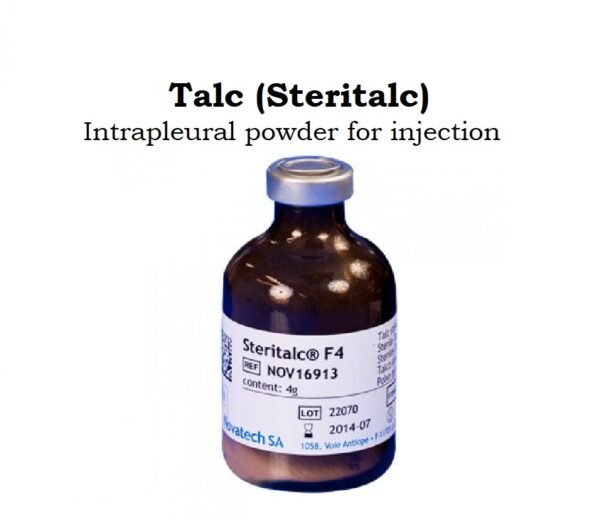Talc is a mineral that is commonly used in various industries. It is known for its softness and its ability to absorb moisture, oils, and odor. Talc is often used in the production of talcum powder, which is widely used in cosmetic products such as baby powder and body powders. It is also used in the production of ceramics, paint, paper, plastics, rubber, and pharmaceuticals. Talc is composed of magnesium, silicon, and oxygen, and it is mined from deposits around the world.
Talc (Steritalc) when injected inside the pleural cavity results in inflammation of the visceral and parietal pleura resulting in their dehiscence. Talc (Steritalc), thus inhibits the accumulation of air and fluid in the pleural cavity.
Indications of Talc (Steritalc) use:
- Malignant Pleural effusion:
- It is effective in preventing the re-accumulation of malignant pleural effusion as a sclerosing agent in symptomatic patients after maximum drainage of the fluid via thoracocentesis.
- Pneumothorax:
- It is used as a sclerosing agent to prevent the recurrence of pneumothorax.
Talc (Steritalc) dosage in adults:
Talc (Steritalc) dose in the treatment of malignant pleural effusion:
For the aerosol method:
- The dose is 4 to 8 grams, which is roughly equal to 1 to 2 cans.
- This is given as a single dose.
For the suspension method:
- Sterile talc powder: 5 grams is used.
- For Steritalc, the dose can vary between 2 to 5 grams depending on the patient's condition, but the total amount should not exceed 10 grams.
Both methods are aimed at reducing fluid buildup in the chest cavity caused by cancer, helping to alleviate symptoms and improve quality of life for the patient.
Talc (Steritalc) dose in the treatment of Pneumothorax:
- When using talc to treat pneumothorax by administering it directly into the chest cavity, the typical dose is 2 grams of Steritalc.
- However, the dose may vary depending on the patient's condition, and other doses could be used.
- It's important not to exceed a maximum cumulative dose of 10 grams to avoid potential complications.
Talc (Steritalc) dosage in children:
Dose in children has not been defined.
Talc (Steritalc) pregnancy Risk Category: D
- Steritalc shouldn't be used during pregnancy because it contains lead, which can harm the baby, leading to miscarriage, premature birth, or developmental issues.
- Even at the highest dose, Steritalc may expose the baby to a concerning level of lead.
- While pneumothorax during pregnancy is rare, the process of pregnancy and childbirth can increase the risk.
- It's crucial for healthcare teams to carefully consider the risks of various treatments for both the mother and the baby.
- Women who could become pregnant should use reliable birth control during Steritalc treatment and for five months afterward.
- Additionally, Steritalc might reduce male fertility by decreasing sperm production.
Talc use during breastfeeding:
- It's uncertain whether sterile talc passes into breast milk.
- However, Steritalc contains lead, which can harm the health and development of newborns, infants, and children.
- Because lead exposure from breastfeeding during Steritalc treatment can lead to serious health issues for the baby, lactating women should avoid breastfeeding while undergoing treatment and for five months after the final dose to minimize the risk of adverse reactions.
Talc (Steritalc) Dose adjustment in renal disease:
- The manufacturer's labeling for Steritalc does not include any specific dosage adjustments for patient with kidney disease.
Talc (Steritalc) Dose adjustment in liver disease:
- The manufacturer's labeling for Steritalc does not include any specific dosage adjustments for patient with liver disease.
Side effects of Talc (Steritalc):
- Cardiovascular:
- Cardiac Arrhythmia
- Hypotension
- Myocardial Infarction
- Pulmonary Embolism
- Tachycardia
- Central Nervous System:
- Pain
- Endocrine & Metabolic:
- Hypovolemia
- Respiratory:
- Acute Respiratory Distress Syndrome
- Bronchopleural Fistula
- Dyspnea
- Empyema Of Pleura
- Hemoptysis
- Pneumonia
- Pneumonitis
- Miscellaneous:
- Fever
Contraindications to Talc (Steritalc):
- According to the manufacturer's labeling, there are no specific contraindications listed for the use of Steritalc or other sterile talc powder products during pregnancy.
- However, as previously discussed, it's important to consider the potential risks associated with lead exposure from Steritalc during pregnancy, which can negatively impact the health and development of the fetus.
Warnings and precautions
Effects on the pulmonary system:
- The use of intrapleural sterile talc, such as Steritalc, can lead to severe pulmonary effects, including acute pneumonitis and acute respiratory distress syndrome (ARDS), which can be fatal.
- Most cases of ARDS have been linked to talc doses of 10 grams administered via a chest tube.
- The risk of systemic exposure to talc is influenced by the integrity of the visceral pleura, and it may increase if talc is given after mechanical pleura abrasion or biopsy.
- Additionally, the size distribution of talc particles may affect the likelihood of toxic reactions.
- These products are specifically intended for intrapleural use, and intravenous administration is not recommended due to the association with pulmonary hypertension and lung parenchymal disease.
- Inhaled talc has been associated with conditions similar to silicosis or asbestosis, including chronic bronchitis, bronchogenic carcinoma, and pleural plaques.
- Therefore, caution must be exercised when using talc products intrapleurally, and the potential risks should be carefully weighed against the benefits.
Sclerosol
- "Sclerosol, like many aerosol products, is under pressure and should be stored away from heat sources or open flames.
- It's important not to puncture the canister to avoid potential hazards."
Steritalc
- Steritalc contains lead as an impurity, which can lead to lead toxicity.
- The central nervous system is the main target, but lead exposure may also affect blood pressure, kidney function, cause anemia, and impact male fertility.
- The safe threshold for lead exposure hasn't been fully determined in humans, and children are particularly sensitive to lead toxicity.
- There isn't a defined safe blood level for children, and exposure can lead to cognitive and behavioral issues.
- Lead exposure during pregnancy can also result in adverse events.
Monitoring parameters:
- Oxygenation (SaO2 and SpO2)
- Respiratory rate
- Clinical features of infection
- Repeated chest radiographs as indicated
How to administer Talc (Steritalc)?
Sclerosol Intrapleural Aerosol:
- Shake well and attach the delivery tube.
- Insert the delivery tube through the pleural trocar.
- Manually press the actuator button of the canister to release the aerosol.
- Point the delivery tube in several different directions to distribute the aerosol to all pleural surfaces.
- Keep the canister upright during administration for optimal distribution.
- The rate of delivery should be 1.2 grams per second.
Sterile Talc Powder (Suspension):
- Shake well before instillation.
- Vent the 10 mL air headspace of each syringe and empty the contents into the chest cavity through the chest tube by gently applying pressure to the syringe plunger.
- After administration, clamp the chest tube for 1 to 2 hours before draining the pleural fluid.
- The chest tube can be removed when drainage is less than 100 to 150 mL per 24 hours.
Steritalc (Slurry for Tube Thoracostomy):
- Shake the syringe well to redisperse the talc and prevent settling.
- Vent the 10 mL air headspace from each syringe immediately before administration.
- Administer the talc suspension through the chest tube following standard procedures.
- Inject the slurry through the pleural drainage into the pleural cavity and clamp the pleural drainage to retain negative pressure.
- Reposition the patient regularly to achieve even slurry distribution and aspirate the slurry through the pleural drainage.
Steritalc (Insufflation/Poudrage):
- Perform the procedure with tube thoracoscopy and follow device instructions.
- After use, some talc may remain in the vial; discard the unused portion.
- For 2 or 4 g vials, introduce the cannula into the trocar and distribute the talc evenly in the pleural cavity by spraying several times and changing the cannula direction every few sprays.
- For 3 g vial, keep the product upright during use and avoid contact between the cannula tip and tissue or body fluids to prevent cannula blockage. If blockage occurs, shorten the cannula with a scalpel and proceed with the intervention by distributing the talc evenly in the pleural cavity using the insufflation bulb carefully and at regular intervals. Change the cannula direction after spraying a few times.
Mechanism of action of Talc (Steritalc):
- Sterile talc, when instilled into the pleural cavity, triggers an inflammatory response. This inflammation encourages the visceral and parietal pleura to stick together, which helps prevent the reaccumulation of pleural air or fluid. Essentially, it promotes adhesion between the layers of tissue lining the lungs and the chest cavity, which reduces the space where air or fluid can collect, aiding in the treatment of conditions like pneumothorax or pleural effusion.
Absorption:
- The absorption of sterile talc into the bloodstream hasn't been extensively studied.
- However, it's believed that systemic exposure to talc may be affected by the condition of the visceral pleura—the membrane covering the lungs.
International Brands of Talc:
- Sclerosol Intrapleural
- Sterile Talc Powder
- Steritalc
Talc Brand Names in Pakistan:
No Brands Available in Pakistan.




 Injection.webp)